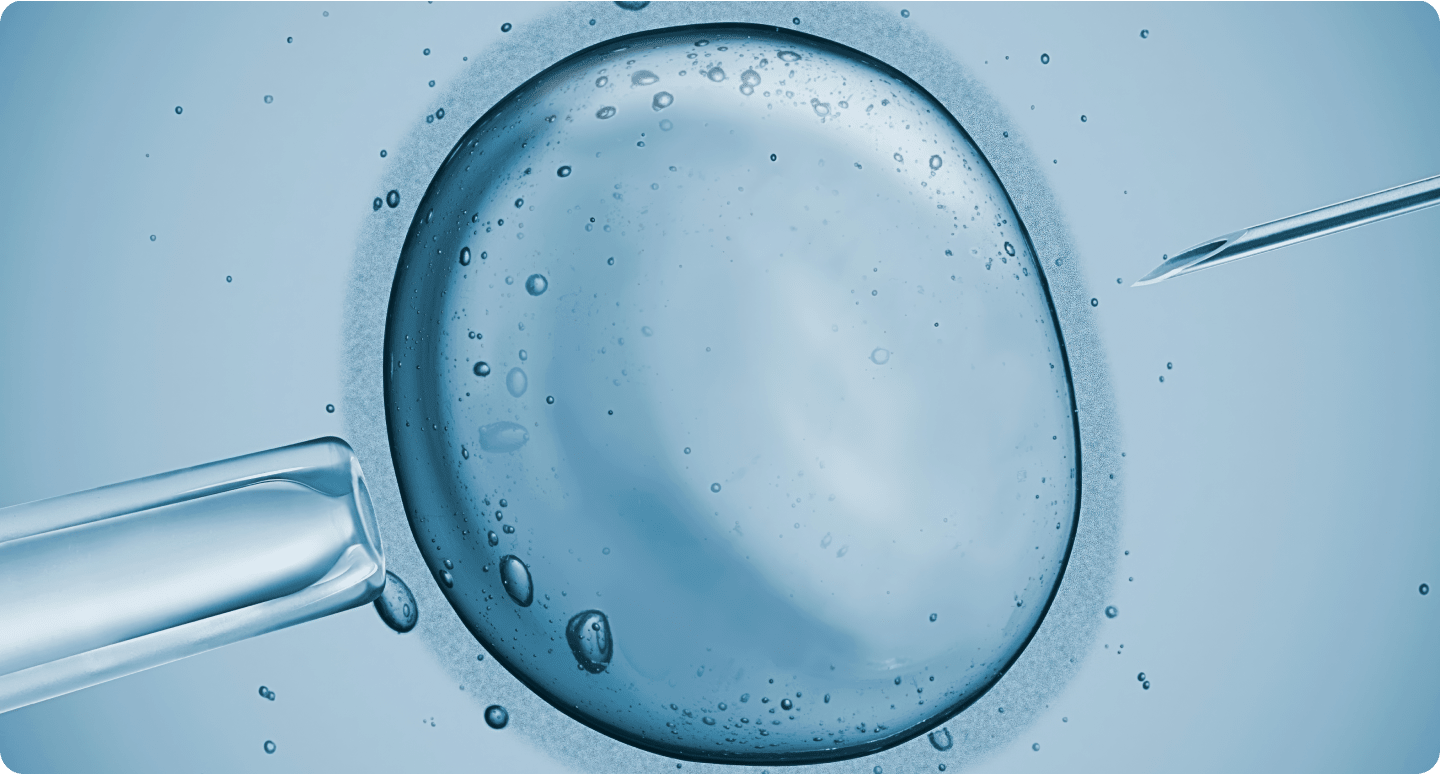Learn everything about the entire process of ICSI, the associated costs, the reasons for such a treatment, and your individual chances of conceiving with ICSI.
Key Facts
- During ICSI, a single sperm cell is injected directly into an egg cell.
- ICSI is performed when sperm cannot fertilise the egg naturally.
- The fertilisation rate with ICSI is 70–80%.
- ICSI's success rate is comparable to IVF, at approximately 30% per treatment cycle.
- ICSI is used for various reasons, including male factor infertility, endometriosis, use of cryopreserved eggs or after preimplantation genetic diagnosis (PGD).
Introduction
The first successful intracytoplasmic sperm injection (ICSI) in humans was performed in 1992 in Brussels, Belgium. This medical breakthrough allowed couples facing male infertility to have their own biological child, reducing the need for donor sperm. Even today, more than thirty years later, ICSI remains a crucial treatment for couples struggling with infertility, especially in cases of reduced sperm quality.
In this article, we'll explain the ICSI process, its potential applications, success rates, and associated costs.
What is ICSI?
Intracytoplasmic sperm injection (ICSI) is a method of assisted reproductive technology (ART) . An embryologist in the laboratory uses a thin pipette to inject a carefully selected sperm directly into the cytoplasm—the interior of a retrieved egg—to facilitate fertilisation.

ICSI Procedure
The ICSI procedure closely resembles IVF, differing primarily in the fertilisation process. A typical ICSI treatment involves two to three check-up appointments at the fertility clinic before the fertilised egg (embryo) is transferred back into the woman's uterus.
1) Downregulation
While not mandatory for ICSI, downregulation is often used to better control the woman's cycle and optimise treatment. This process temporarily suppresses the woman's natural hormone production with medication, preventing premature ovulation and stimulating the maturation of multiple eggs—thereby increasing the chances of successful fertilisation.
2) Ovarian Stimulation
The female partner receives daily hormone injections (usually gonadotropins) to stimulate follicle growth in the ovaries (ovarian stimulation). One egg matures in each follicle.
3) Ultrasound Checks and Blood Tests
Regular ultrasound examinations and blood tests monitor follicle growth and hormone levels, allowing for treatment adjustments if necessary.
4) Triggering Ovulation
Once follicles reach a size of 18–22 mm, ovulation is triggered by a hormone injection (hCG or GnRH analogues).
5) Follicle Puncture & Oocyte Retrieval
Approximately 36 hours after triggering ovulation, mature eggs are retrieved under ultrasound guidance and light anesthesia. This process takes about 20–30 minutes.
6) Sperm Retrieval
On egg retrieval day, a semen sample is obtained from the man, typically through masturbation. Alternative methods like surgical sperm retrieval from the testicles or epididymis (TESE or MESA) are available if needed. The collected sperm is prepared in the laboratory to select the most motile and healthy sperm for fertilization. Donor sperm can also be used.
7) Egg Fertilisation
Under a microscope, an embryologist injects a single sperm cell directly into the egg using a fine needle. The fertilized eggs are then cultured and observed in a special incubator to monitor their development.
8) Embryo Transfer
A few days after fertilisation (usually on day 3 or 5), one or more embryos are selected and transferred into the woman's uterus. This procedure is typically done without anesthesia and is relatively painless.
9) Cryopreservation
Unused embryos can be frozen (cryopreserved) and stored for future treatment cycles. This increases the chances of pregnancy without requiring additional stimulation and egg retrieval.
10) Pregnancy Test
About two weeks after the embryo transfer, a pregnancy test can be taken to determine if implantation has occurred. If the test is positive, further examinations will be conducted to confirm and monitor the pregnancy.
When is ICSI Used?
ICSI is used for various reasons. Most commonly, it's performed due to poor sperm quality. However, a hardened zona pellucida (the egg's outer layer) can also necessitate the use of ICSI.
Male Infertility
- Poor sperm quality: Low sperm count (oligozoospermia), limited motility (asthenozoospermia) or abnormal sperm shapes (teratozoospermia)
- Azoospermia: No sperm in the ejaculate, requiring surgical sperm retrieval (TESE/MESA)
- Impaired sperm production: Hormonal disorders (hypogonadism) or genetic causes (e.g., Klinefelter syndrome)
Female Infertility
- Endometriosis: A condition where tissue similar to the endometrial lining grows outside the uterine cavity
- Other causes: Blocked fallopian tubes or advanced age
Unexplained Infertility
- Idiopathic infertility: When no specific cause for infertility can be identified
Additional Indications
- Unsuccessful IVF cycles: When conventional IVF treatments have failed
- Preimplantation genetic diagnosis (PGD): For genetic testing of embryos before transfer
- Use of cryopreserved eggs
How Long Does ICSI Take?
An ICSI treatment typically lasts between 4 and 6 weeks, depending on the stimulation protocol used. The long protocol, which includes downregulation in the previous cycle, takes about 6 weeks. In contrast, the short protocol takes approximately 4 weeks.
What are the Chances of Success with ICSI?
Success rates for ICSI vary, primarily depending on the woman's age and the cause of infertility. Generally, the pregnancy rate per treatment cycle is about 30–45%.
While transferring multiple embryos can increase the chances of success, it also carries an increased risk of multiple pregnancies. Modern reproductive medicine typically transfers a single embryo on day 5 (blastocyst stage), which enhances pregnancy rates while significantly reducing multiple pregnancy risks.

ICSI Costs
In Switzerland, ICSI costs typically range from CHF 5,000 to 8,500 per treatment cycle, including medical services, medications and laboratory tests.
Basic health insurance generally doesn't cover ICSI costs in Switzerland.
However, some health insurance companies offer supplementary coverage for fertility treatments, potentially covering part of the ICSI costs. It's advisable to check with your health insurance provider about available options.
Frequently Asked Questions
What is the difference between ICSI and IVF?
ICSI and in vitro fertilisation (IVF) are similar procedures, but their fertilisation methods differ significantly. In IVF, eggs and sperm are combined in a Petri dish, allowing fertilisation to occur naturally. In contrast, ICSI involves directly injecting a single sperm cell into the egg.
This targeted approach makes ICSI the preferred method for cases of male infertility, where sperm may struggle to reach and fertilise the egg independently.
Is ICSI possible in a natural cycle?
Yes, ICSI can be performed in a natural cycle, although the success rates are lower compared to hormonal stimulation. In this approach, the woman's natural cycle is closely monitored, and egg retrieval is timed with ovulation. This method is particularly suitable for women with a good egg reserve and regular cycles.
How many ICSI attempts are typically needed to achieve pregnancy?
The number of ICSI attempts required varies widely and depends on several factors, including the woman's age, the cause of infertility and embryo quality. On average, about 2–3 attempts are needed to achieve pregnancy. Multiple treatment cycles can increase the chances of success.
Takeaway
ICSI provides couples struggling with infertility, particularly due to male factor issues, a promising path to biological parenthood. While the treatment can be time-consuming and expensive, it has helped numerous couples realise their dream of having a child. ICSI's targeted approach offers hope, especially in cases where traditional methods have been unsuccessful.







